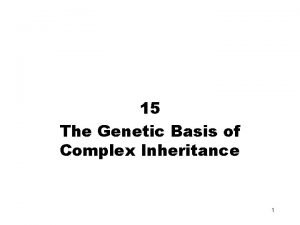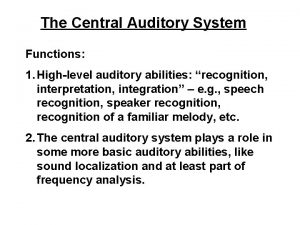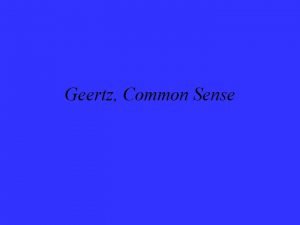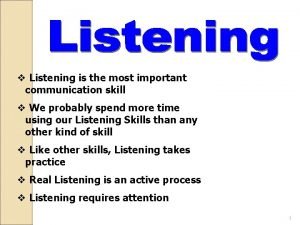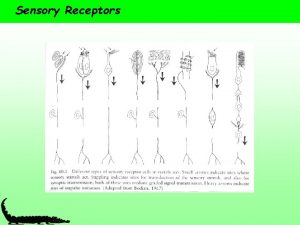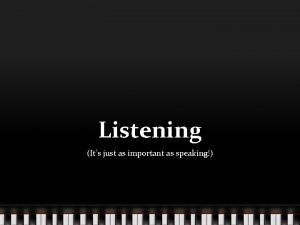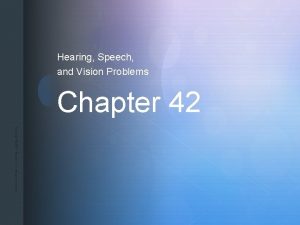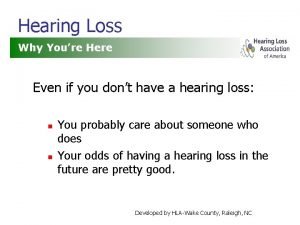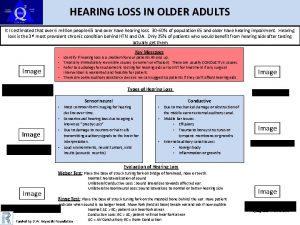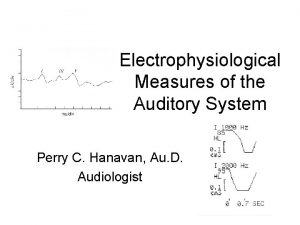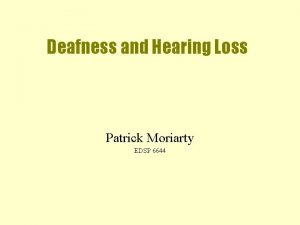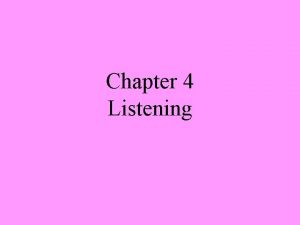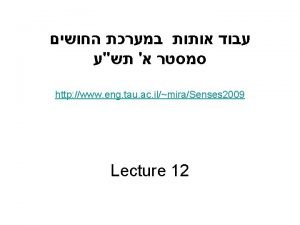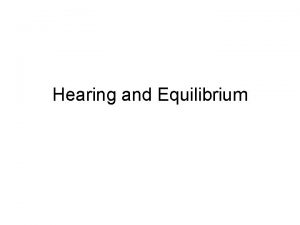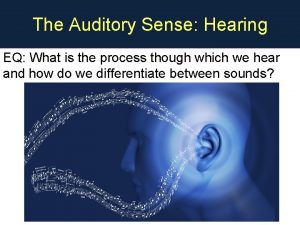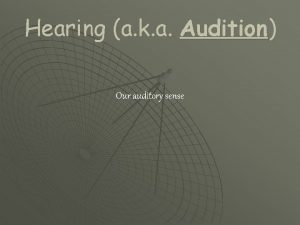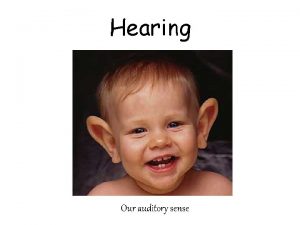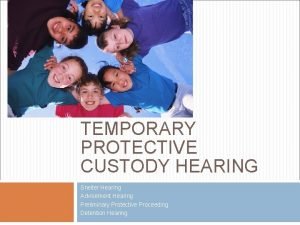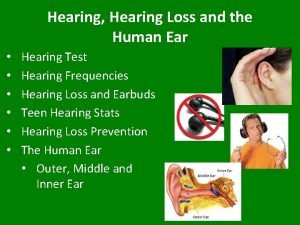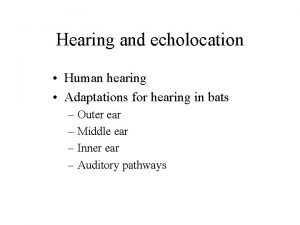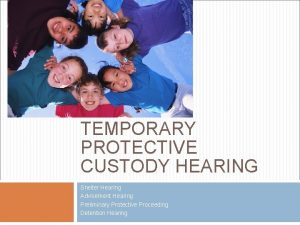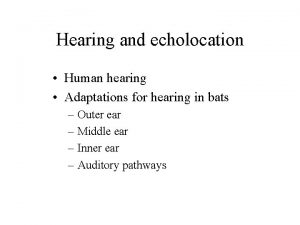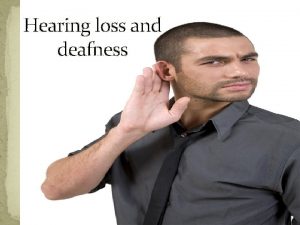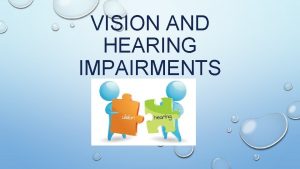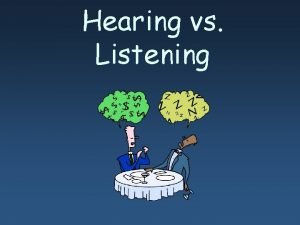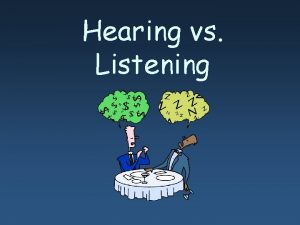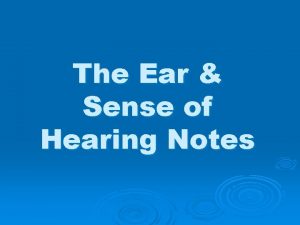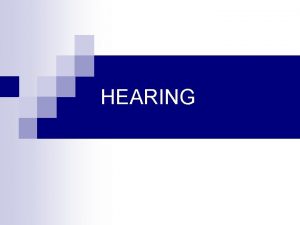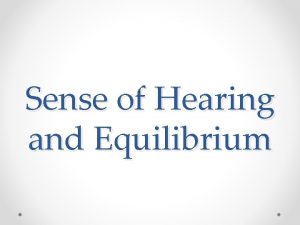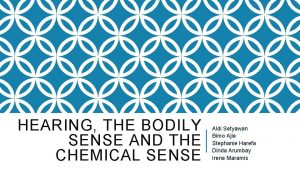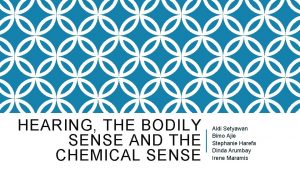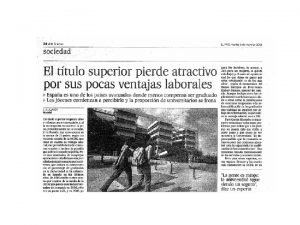THE AUDITORY SYSTEM SENSE OF HEARING THE AUDITORY






























- Slides: 30

THE AUDITORY SYSTEM SENSE OF HEARING

THE AUDITORY SYSTEM v. Mechanoreception: detection of vibration, perceived as hearing v. Stimulus: sound waves v. Sense organ: ears v. Function: hearing v. Auditory transduction: transforms sound waves into electrochemical impulses that the brain can interpret

SOUND WAVE PROPERTIES v. Sound has 3 characteristics: 1. Wavelength: frequency (determines pitch) • longer = lower frequency = lower pitch • shorter = higher frequency = higher pitch • measured in hertz = Hz 2. Wave amplitude: intensity (determines loudness) • shorter = less intensity = quieter • taller= more intensity = louder • measured in decibels = d. B • roughly every 10 d. B doubles loudness 3. Purity: quality (determines timbre/tone saturation) • uniqueness of sound


PARTS OF THE EAR v. Outer ear – air conduction Ø Pinna Ø Auditory canal v. Middle ear – bone conduction Ø Eardrum (tympanic membrane) Ø Ossicles § Hammer (malleus), anvil (incus), stirrup (stapes) v. Inner ear – fluid conduction Ø Oval window Ø Cochlea § Basilar membrane and hair cells Ø Semicircular canals § Vestibular sacs Ø Auditory nerve


PITCH PERCEPTION Place Theory v. States that each frequency produces vibrations at a particular spot on the basilar membrane. v. Location v. Explains high pitched sounds Frequency Theory v. States that the perception of a sound's frequency depends on how often the auditory nerve fires. v. Neural impulses v. Explains low pitched sounds

VOLLEY PRINCIPLE v. Modification of frequency theory stating that a cluster of nerve cells can fire neural impulses in rapid succession, producing a volley of impulses. ØFixes limitations of frequency theory

AUDITORY LOCALIZATION v. We have two ears v. Sounds may reach one ear faster than the other ear v. Or sounds may be louder in one ear than another v. This let’s us locate the sound v. Our head acts as a “shadow” v. Sound shadow v. Can not localize if directly in front, back or above

HEARING LOSS Conductive Hearing Loss Sensorineural Hearing Loss vhearing loss occurs when there v. Hearing loss occurs when is damage to the inner sound is not conducted ear (cochlea), or to the nerve efficiently through the outer pathways from the inner ear to ear canal to the eardrum and the brain. the tiny bones (ossicles) of v. Most of the time, cannot be the middle ear. medically or surgically corrected. v. Usually involves a reduction in vmost common type of sound level or the ability to hear permanent hearing loss. faint sounds. vreduces the ability to hear faint v. Can often be corrected sounds. medically or surgically v. Caused by damage to the cochlea or to the auditory nerve v. Caused by damage Mixed to the parts Hearing Loss

HEARING LOSS

THE TACTILE SYSTEM SENSE OF TOUCH

THE TACTILE SYSTEM v. Mechanoreception: detection of pressure, perceived as touch v. Thermoreception: detection of temperature; perceived as warm and cold v. Nociceptors: detection of noxious stimuli; perceived as pain v. Stimulus: mechanical, thermal, and chemical energy v. Sense organ: skin v. Function: touching v. Tactile transduction: transforms mechanical, thermal, and chemical energy on the skin into electrochemical impulses

THE SENSORY SYSTEM v Three kinds of receptors: Ø touch Ø temperature § warm § cold Ø pain v Four distinct skin senses: Ø pressure Ø warmth Ø cold Ø pain v Extreme heat & extreme cold are THE SAME!

PAIN v. Pain tells the body that something has gone wrong. v. Congenital Insensitivity to Pain (CIP): A rare disease in which the afflicted person feels no pain. Øno sense of smell Øunable to sweat Øsodium channel mutation

PAIN PATHWAYS v. Two pain pathways: Øfast § A-delta fibers • less than 1 second • myelinated Øslow § C fibers • a couple of seconds • unmyelinated

PAIN PERCEPTION v. Gate Control Theory: Øcreates neural blockage ØStudied by Ronald Melzack & Patricia Wall (1965)

ENDORPHINS v. Neurotransmitters vnatural opiate vmorphine-like painkillers

THE GUSTATORY SYSTEM SENSE OF TASTE

THE GUSTATORY SYSTEM v. Chemoreception: detection of chemical stimuli, perceived as taste v. Stimulus: soluble chemicals v. Sense organ: tongue v. Function: tasting v. Gustatory transduction: transforms soluble chemicals in food into electrochemical impulses that the brain can interpret

THE OLFACTORY SYSTEM SENSE OF SMELL

THE OLFACTORY SYSTEM v. Chemoreception: detection of chemical stimuli, perceived as smell v. Stimulus: volatile chemicals v. Sense organ: nose v. Function: smelling v. Olfactory transduction: transforms volatile chemicals in the air into electrochemical impulses that the brain can interpret

THE KINESTHETIC SYSTEM SENSE OF POSITION & MOVEMENT

THE KINESTHETIC SYSTEM v. Mechanoreception: detection of vibration, perceived as hearing v. Stimulus: sound waves v. Sense organ: ears v. Function: hearing v. Auditory transduction: transforms sound waves into electrochemical impulses that the brain can interpret

THE VESTIBULAR SYSTEM SENSE OF BALABNCE & MOVEMENT

THE VESTIBULAR SYSTEM v. Mechanoreception: detection of vibration, perceived as hearing v. Stimulus: sound waves v. Sense organ: ears v. Function: hearing v. Auditory transduction: transforms sound waves into electrochemical impulses that the brain can interpret

THE th 6 SENSE EXTRASENSORY PERCEPTION (ESP)

PARAPSYCHOLOGY v. The study of paranormal phenomena. ØOver 75 years of research ØNo evidence of paranormal phenomena exists

EXTRASENSORY PERCEPTION v. Perception without sensory input. ØEnergy source? ØSensory receptors? v. Paranormal phenomena include: ØAstrological predictions, psychic healing, communication with the dead, out-of-body experiences, telepathy, clairvoyance, and precognition.

TYPES OF ESP v. Telepathy: Mind-to-mind communication. One person sending thoughts and the other receiving them. v. Clairvoyance: Perception of remote events. v. Precognition: Perceiving future events.
 Dominant genetic variance
Dominant genetic variance Narrow sense heritability vs broad sense heritability
Narrow sense heritability vs broad sense heritability Function of auditory system
Function of auditory system Bser aer
Bser aer Common sense examples
Common sense examples Discriminative listening
Discriminative listening Importance of effective listening skills
Importance of effective listening skills We listen
We listen Where does transduction occur in the ear
Where does transduction occur in the ear Falling action romeo and juliet
Falling action romeo and juliet Hearing on advisement
Hearing on advisement Types of listening
Types of listening Hearing personalauswahl
Hearing personalauswahl Signs for seeing asl answers
Signs for seeing asl answers Hearing loss icd-10
Hearing loss icd-10 Hoglund brain imaging center
Hoglund brain imaging center To hear with attention
To hear with attention Chapter 42 hearing speech and vision problems
Chapter 42 hearing speech and vision problems Cookie bite hearing loss
Cookie bite hearing loss Conductive hearing loss lateralization
Conductive hearing loss lateralization Type c tympanogram hearing loss
Type c tympanogram hearing loss Ewc hearing outcomes
Ewc hearing outcomes Noah hearing aid
Noah hearing aid Hearing impairment meaning
Hearing impairment meaning Rinne test
Rinne test Hearing and equilibrium
Hearing and equilibrium Active listening vs hearing
Active listening vs hearing Listening
Listening Loudermill hearing
Loudermill hearing Public hearing for environmental clearance
Public hearing for environmental clearance Hearing neural pathway
Hearing neural pathway

